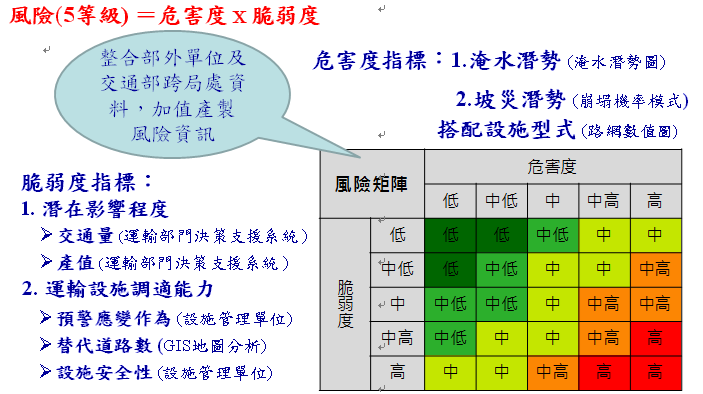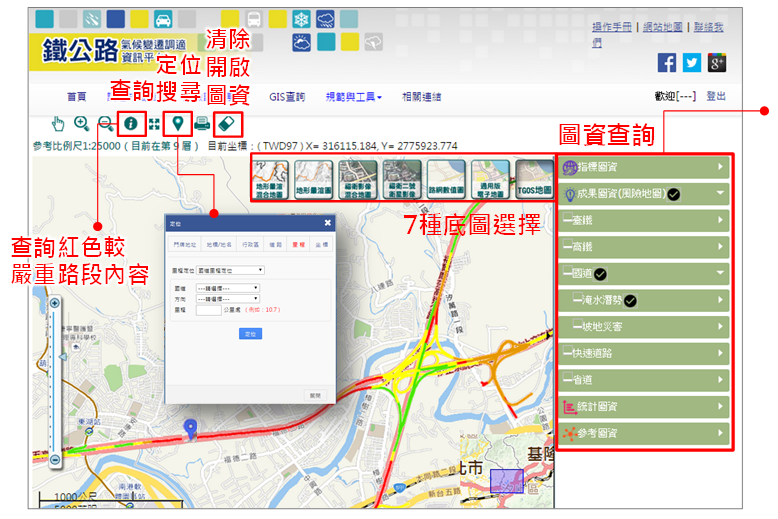The railway and highway’s risk assessment methods and adaptation strategies for climate change
- Date:2019-03-06
- Update:2019-03-06
- Department:IOT
Project Overview:
The impact of climate change on the infrastructure of various countries is increasingly obvious and serious. The United Nations Intergovernmental Panel on Climate Change (IPCC) has presented the risk implications of climate change impact in the 4th climate assessment report, explaining the hazards and vulnerabilities to be considered in the climate change risks.
The "Adaptation Strategy to Climate Change in Taiwan" unveils the national level adaptation strategy objectives of Taiwan. The Greenhouse Gas Reduction and Management Act also stipulates that the central competent authorities in charge of the key business sectors must conduct research on adaptation strategies. The transportation system is an important infrastructure with the road network of intensive railways and highways system that provide the main transportation services, therefore, this Institute takes the railways and highway system as the scope of its research to evaluate the flooding and slope disasters in various road sections under climate changes that resulted in the risks of inability to pass and degree of impact to society and economy, as a reference for the railways and highways management agencies to propose detailed specific adaptation action plans.
Research Outcomes:
(1)We established an assessment method for climate change risks of railways and highways using the existing data of agencies with added value: Analyze the flooding and slope disaster levels of each road section of railways and highways with a two-dimensional matrix (risk = level of harm x vulnerability); the level of harm uses flooding simulation map data (Water Resources Agency) and a landslide probability model (Sinotech Engineering Consultants, Inc.); vulnerability is based on the traffic volume of each road section, the township production output value of the road section service area, early warning monitoring capability and facility safety as the assessment indicators.
(2)We constructed the Railways and Highways Climate Change Adaptation Information Platform: We established a Climate Change Risk Information Platform for national highways, provincial highways, expressways, high-speed rails and Taiwan railways with SuperGis software. We provided an online inquiry interfacefor management agencies to query the degree of harm, vulnerability and risk level of the various road sections of the facilities under their jurisdiction in different recurrence periods of climate change.
(3)We completed the recommendations for Railways and Highways Climate Change Adaptation Action Plan: Through the railways and highways climate change risk assessment, a facility management agency questionnaire survey and interviews to grasp the causes of disaster points, we improved the effectiveness and inventoried the railways and highways adaption gap. With the five major aspects of assessment tools, risk management, facility toughness, post-disaster reconstruction, cross-field integration we summarized 31 recommendations for the Action Plan.
Promotion of Outcomes and Benefits :
(1)We presented the "A GIS-based Tool for Adaptation Analysis for Taiwan's Highway and Railways" at the 7th Asian Regional Science Symposium to promote the research methodology and GIS platform tools to all academic and research sectors.
(2)This Institute has regularly invited the agencies (Directorate General of Highways, Taiwan Railways Administration, Freeway Bureau, Bureau of High Speed Rail, Railway Reconstruction Bureau, and Taiwan High Speed Rail Corporation) over the past three years, to organize education and training on the Railways and Highways Climate Change Adaptation Information Platform, and promote the climate change adaptation concept and platform functions to enable the Directorate General of Highways, Taiwan Railways Administration and other agencies to apply the platform in their actual facilities management and maintenance operations.
(3)The main outcomes of this project are to provide a rapid grasp of initial risk information of the entire Taiwan road network for the Railways and Highways Facility Management Agencies under the constraints of their limited manpower and resources, promote and provide the Directorate General of Highways, Taiwan Railways Administration and other agencies to further examine and confirm the high risk causes and promote the specific improvement plans, to effectively improve the adaptation capability of railways and highways systems.









